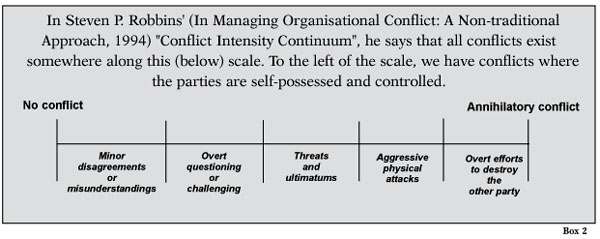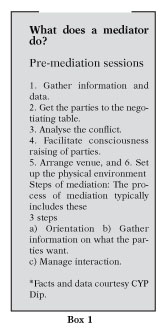|
observer |
|
|
|
|
|
OTHER LINKS |

|

|

|
Many apects of 'conflict resolution'
Many different approaches to resolve this situation over the past years have left the parties involved in a deadlock, often resulting in discontinuity or delayed outcomes. Managing conflict requires taking into consideration the different levels of conflict, its causes and the many applications that can be used in such situations. It may seem timely to shed light in a different perspective, of the conflict. Rather than of its brutality and horrors that we all know, it may be relevant to familiarise with the present situation in the 'negotiating' context. Conflict resolution can only begin in analysing the causes first. In this effort, it would be holistic to at least briefly explain the many faceted concept of conflict and the steps that involve before coming to finding solutions. Four levelsConflict occurs on four different levels, namely Intra-personal (within an individual), Inter-personal (between two or more individuals), Intra-group (within a group) and Inter-group (between two or groups). With regard to the conflict in Sri Lanka, we can take it to be in the Inter-group level, however at the onset it may have been in the Inter-personal level. This shows that conflict can occur on more than one level at the same time. Although there are many perceptions and definitions of conflict, the criteria for the existence of 'war' in our country can be taken with the visible signs of bloodshed and open struggle. However, in most cases the cause of conflict can be taken as a result of competing or striving for the scarce resources at the same time and as a process that begins when one party feels that another party has negatively affected (Robbins, 1994) something the first person cares about. In finding solutions, specially on a issue at the macro level, it may be helpful in studying and applying theories to the analysis of such situations as it also helps to recognise the conflict situations when they are encountered in different stages so that we can develop a theoretical framework to address the issue in a more constructive manner. Functionalist viewFunctionalist or traditional view of conflict is that conflict should be avoided under any circumstance as it means the dysfunctioning of a group or a breakdown in a relationship. Human relations view believe that conflict is inevitable and is characteristics of groups and relationships, it also perceives that conflict is not destructive and has the potential for positive outcomes. Interactionists believe it is absolutely essential for a proper and healthy functioning of a group or relationship. The Structuralist view is that conflict is a dynamic force rooted in the dominating structure, based on opposing interests. Despite many debates and contradictory views, it is the traditional view on conflict that receives the majority support. In resolving conflict, there are many strategies that can be applied. The African Centre for the Constructive Resolution of Disputes (ACCORD) in "Conflict Management, Negotiation and Mediation Skills" says there are only three approaches for ending conflict: Power, Rights or standards and Agreement. However, there are various different approaches and methods that can be applied. Of these, the five stages of the Conflict Process Model proves to be a useful tool in understanding a conflict situation. It consist of Potential for Conflict, Recognition of Conflict, Conflict Handling Styles, Conflict Behaviour and Conflict Outcomes. Five conflict handling styles
Similarly, there are other conflict management approaches such as Bargaining Strategies. In Distributive Bargaining the negotiating process continues until an agreement is reached. Integrative Bargaining is based on the assumption that there is more than one solution to a problem which results in a win/win situation. Coming now to the stage where we may already be familiar with is having a third party in the process of conflict resolution. In the Sri Lankan peace process, we have third party involvement at the negotiating table. As there had been and still, at intervals experience deadlocks, it may be that a suitable 'plan of action is needed. Maybe, if one method fails to yield results, then it is best to adopt another approach until you find a constructive way to find a lasting solution. In this regard, it is always good to be knowledgeable about a range of theories. In this context, there are four basic negotiation processes: Mediation, Arbitration, Conciliation and Consultation. In Arbitration, the intervention of a third party has a formal binding authority to dictate an agreement. Conciliation involves a trusted third party that serves as an informal communication link between the two parties. In Consultation, it involves a neutral third party who attempts to facilitate creative problem solving through analysis and research. Of the four processes, what may be 'close to home' is the Mediation process. In Mediation, although it has no formal binding authority to use persuasion, reasoning and suggestions it helps to facilitate the negotiation of a solution. This intervention is usually carried out with the involvement of a third party who is impartial and who has no personal biases with the parties involved (also refer Box 01). Mediator's roleThe mediator/manager's role in a conflict situation or dispute is perhaps, the most important task in the negotiating process. It plays a vital role in this instance as the affected parties are usually in a hostile relationship with no direct contact. The third party serves as a doctor who (should) diagnose the 'illness' before a suitable 'medication' is prescribed. Whatever may be the approach adopted, Mediation should seek to address all these following aspects: Change attitudes, change behaviour, change structures, manage power differences, manage societal differences and encourage participation. As it may be worthy to note, Dudley Week's (The Conflict Partnership Process for Effective Conflict Resolution and Relationship Building) eight step process for effective negotiations shows that in Inter-personal disputes (of conflict), the following serves as indispensable conflict resolution tools: Invite a partnership atmosphere, clarify perceptions, focus on individual and shared needs, develop shared positive power, focus on the present and future and learn from the past, generate options, develop and agree on doables and develop mutual benefit proposals and agreements. A comprehensive study of these points will elaborate more on its effectiveness in finding a suitable solution to a problem. It has to be stated that an accurate study of the conflict is the all important factor that would decide in the success or failure of conflict resolution. While many of these approaches and theories have strengths and weaknesses, different implications and assumptions, the key to the door of peace lies within the parties involved. Although joint discussions may not be the only response or way of proceeding, it may bring about a valuable outcome in the process to find a mutual and peaceful approach. |
 Sri
Lanka is at the threshold of negotiating peace. Whether it would be
successful or not depends on the parties involved. However, the
understanding of the conflict situation plays a pivotal role and is the
deciding factor in finding lasting peace to a problem that has been
escalating year after year for more than two decades.
Sri
Lanka is at the threshold of negotiating peace. Whether it would be
successful or not depends on the parties involved. However, the
understanding of the conflict situation plays a pivotal role and is the
deciding factor in finding lasting peace to a problem that has been
escalating year after year for more than two decades.  Of
the above, stage three, Conflict Handling Styles is a better way to
handle and minimise the effects of conflict as and when it is recognised.
Kenneth Thomas in his book explains five conflict handling styles, using
two dimensions: Cooperativeness(satisfy the needs and wants of the other
party) and Assertiveness(satisfy his or her own needs). Competing is
where the aim is to win at all costs. Collaborating or win/win is where
both parties strive for a solution to satisfy the needs of both parties.
Avoiding is where the desire to withdraw is stronger than the desire to
resolve it. Accommodating is placing the needs of the other party above
one's own needs. Compromising is where both parties settle for a partial
solution and give up something of value. In Compromising, neither party
is a clear winner. These methods of controlling/handling a conflict can
develop creative and practical responses to problems.(See also Box 2)
Of
the above, stage three, Conflict Handling Styles is a better way to
handle and minimise the effects of conflict as and when it is recognised.
Kenneth Thomas in his book explains five conflict handling styles, using
two dimensions: Cooperativeness(satisfy the needs and wants of the other
party) and Assertiveness(satisfy his or her own needs). Competing is
where the aim is to win at all costs. Collaborating or win/win is where
both parties strive for a solution to satisfy the needs of both parties.
Avoiding is where the desire to withdraw is stronger than the desire to
resolve it. Accommodating is placing the needs of the other party above
one's own needs. Compromising is where both parties settle for a partial
solution and give up something of value. In Compromising, neither party
is a clear winner. These methods of controlling/handling a conflict can
develop creative and practical responses to problems.(See also Box 2)









